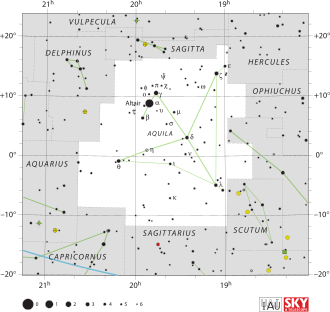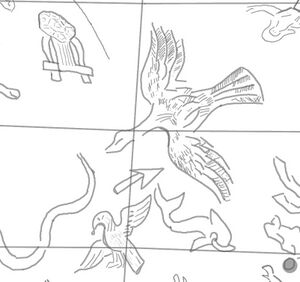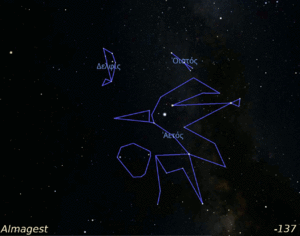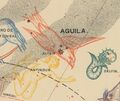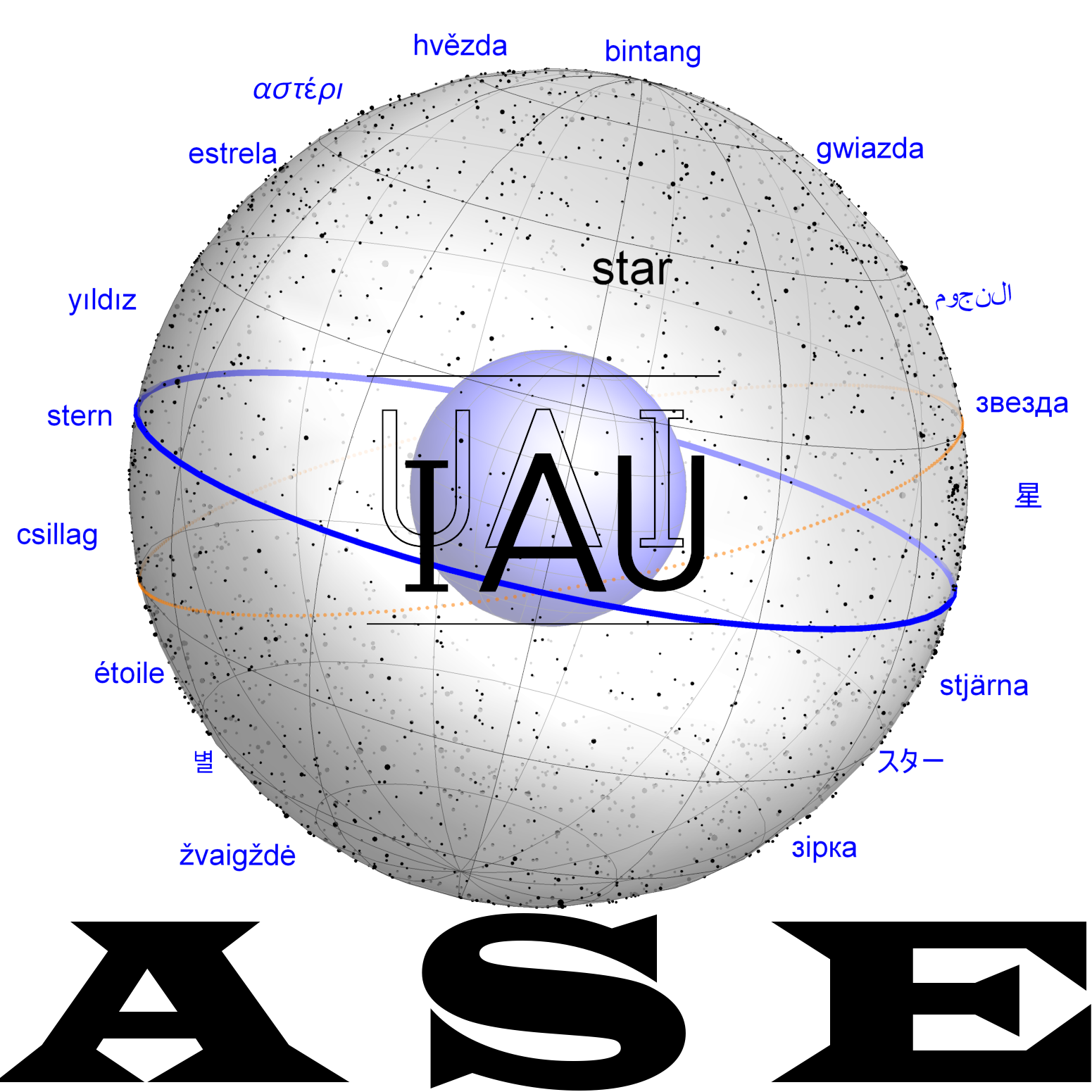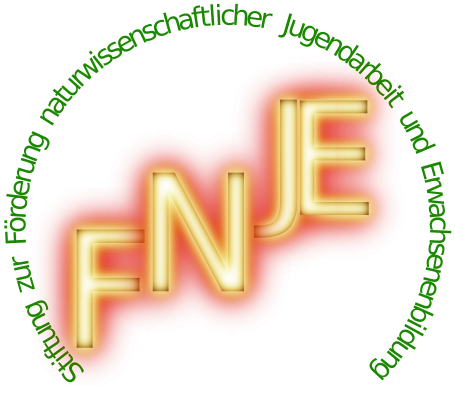Aquila: Difference between revisions
No edit summary Tags: Visual edit: Switched Disambiguation links |
No edit summary |
||
| (25 intermediate revisions by 5 users not shown) | |||
| Line 1: | Line 1: | ||
[[File:Aquila IAU.svg|thumb|Aquila as IAU constellation in the borders of 1930s, IAU & S&T. ]] |
|||
Aquila, The Eagle, is one of the official IAU-constellations. Its history goes back to a Sumerian constellations (TI<sub>8</sub>, The Eagle) in the same area of the sky. |
|||
[[File:KugelGlobe Sge.JPG|thumb|Earliest known depiction of Cyg, Lyr, Del, Aql and Sge on the Kugel Globe (1st century BCE), SMH 2024.]] |
|||
Aquila, The Eagle, is one of the official IAU-constellations. Its history goes back to a Sumerian constellations ([[TE8.mušen|TI<sub>8</sub><sup>muš</sup>]]<sup>en</sup>, The Eagle or The Vulture) in the same area of the sky. In Babylonian uranography, the neighboring constellation is a corpse and in Ptolemy's Almagest, the asterism of [[Antinous]] (a recently past away and deified favourit of the Roman emperor) is split off. |
|||
== |
== Etymology and History == |
||
"Aquila" is the Latin translation of the Ancient Greek term which is the translation of an Akkadian term which is the translation of a Sumerian term. It is unknown whether the Sumerians distinguished betwen eagles and vultures. The Greek term and mythology clearly refer to an eagle as a symbol of divine power. Still, the original Sumerian constellation might have had a different context: as it was placed next to the Sumerian constellation of The Corpse, the bird might have been considered a vulture. |
|||
The confusion of the Eagle and the Vulture can be traced throughout all epochs. In medieval manuscripts Aquilae was also commonly known as "vultur volans", see [https://www.thesaxlproject.com/assets/Uploads/00-Aquila-Master-0-R-6-October-2023.pdf Saxl-Project] while similarly, the (originally Arabian) eagle in [[Lyra]] also got the Latin name "vultur cadens". These names are preserved in late-medieval European astrolabes, star catalogues and from the sixteenth-century onwards on celestial globes. See for example the celestial globe [https://nla.gov.au/nla.obj-233257345/view (1551) of Gerard Mercator]. The term "lucida vulturis" for Altair remained popular until far into the 17th century, and Bode's celestial atlas uses the German rhyme "der Geyer mit der Leyer" (the vulture with the lyre) for [[Lyra]]. |
|||
== Transfer and Transformation of the constellation == |
|||
=== Origin of constellation === |
|||
The constellation of The Eagle [[TE8.mušen|<sup>mul</sup>TE<sub>8</sub>]] is listed in the Mesopotamian creation myth "Enuma Anu Enlil", in Astrolab P and Astrolab B, and in MUL.APIN's first list, all dating to the 2nd millennium BCE. |
|||
=== Graeco-Roman constellation === |
|||
===== Aratos ===== |
|||
<blockquote>[311] Ahead of the Archer is another Arrow lying all by itself without a bow. The Bird is outstretched beside it, nearer to the north. Close to it another bird is wafted, inferior in size, but stormy when it rises from the sea at the departure of night; and men call it the Eagle. (Kidd 1997)</blockquote> |
|||
===== Eratosthenes ===== |
|||
===== Hipparchus ===== |
|||
===== Geminos ===== |
|||
[[File:Aql Alm+Farnese stellarium.gif|thumb|Aquila as stickfigure drawn to the description in the Almagest (137 CE) and as drawn on the Farnese Globe (marble, 2nd c. CE), mapped to Stellarium by Susanne M Hoffmann (2021)]] |
|||
===== Ptolemy's Almagest Αετός. ===== |
|||
{| class="wikitable" |
|||
! |
|||
!Greek |
|||
(Heiberg 1898) |
|||
!English |
|||
(Toomer 1984) |
|||
!ident. |
|||
|- |
|||
! |
|||
!Αετοῦ ἀστερισμός |
|||
! |
|||
! |
|||
|- |
|||
| |
|||
|ὁ ἐῃ μέσῃ τῇ κεφαλῇ |
|||
|The star in the middle of the head |
|||
|τ Aql |
|||
|- |
|||
| |
|||
|ὁ τούτου προηγούμενος καὶ ἐπὶ τοῦ τραχήλου. |
|||
|The one in advance of this, on the neck |
|||
|β Aql |
|||
|- |
|||
| |
|||
|ὁ ἐπὶ τοῦ μεταφρένου λαμπρὸς καλούμενος Ἀετός |
|||
|The bright star on the place between the shoulders, called Aquila |
|||
|αAql |
|||
|- |
|||
| |
|||
|ὁ τούτου σύνεγγυς ἀπ’ ἄρκτων |
|||
|The one close to this towards the north |
|||
|ο Aql |
|||
|- |
|||
| |
|||
|τῶν ἐν τῷ ἀριστερῷ ὤμῳ β ὁ προηγούμενος. |
|||
|The more advanced of the 2 in the left shoulder |
|||
|γ Aql |
|||
|- |
|||
| |
|||
|ὁ ἐπόμενος αὐτῶν |
|||
|The rearmost of them |
|||
|φ Aql |
|||
|- |
|||
| |
|||
|ὁ τῶν ἐν τῷ δεξιῷ ὤμῳ δύο ὁ προηγούμενος |
|||
|The more advanced of the two in the right shoulder |
|||
|μ Aql |
|||
|- |
|||
| |
|||
|ὁ ἑπόμευος αὐτῶν |
|||
|The rearmost of them |
|||
|σ Aql |
|||
|- |
|||
| |
|||
|ὁ ὑπὸ τὴν οὐρὰν τοῦ Ἀετοῦ ἀπωτέρω ἀπτόμενος τοῦ γαλαξίου. |
|||
|The star some distance under the tail of Aquila, touching the Milky Way |
|||
|ζ Aql |
|||
|- |
|||
| |
|||
| |
|||
| |
|||
| |
|||
|- |
|||
|all |
|||
|ἀστέρες ὅ, ὥν β’ μεγέθους ἄ, γ’ ὅ, δ’ α, ε' γ' |
|||
|9 stars, 1 of the second magnitude, 4ofthe third, 1 of the fourth, 3 of the fifth |
|||
| |
|||
|- |
|||
| |
|||
| |
|||
| |
|||
| |
|||
|- |
|||
! |
|||
!Οἱ περὶ τὸν άετόν, ἐφ’ ὧν ὁ Ἀντίνοος |
|||
!The stars araund Aquila, to which the name 'Antinous' is given |
|||
! |
|||
|- |
|||
| |
|||
|Τὸ τῶν ἀπὸ φότου τῆς κεφαλῆς τοῦ Ἀετοῦ β ὁ προηγούμενος, |
|||
|The more advanced of the 2 stars south of the head of Aquila |
|||
|η Aql |
|||
|- |
|||
| |
|||
|ὁ ἐπόμερος αὐτῶν |
|||
|The rearmost of them |
|||
|θ Aql |
|||
|- |
|||
| |
|||
|ὁ ἀπὸ νότου καὶ λιβὸς τοῦ δεξιοῦ ὤμου τοῦ Ἀετοῦ. |
|||
|The star to the south and west of the right shoulder of Aquila |
|||
|δ Aql |
|||
|- |
|||
| |
|||
|ὁ τούτου ἀπὸ μεσημβρίας |
|||
|The one to the south of this |
|||
|ι Aql |
|||
|- |
|||
| |
|||
|ὁ ἔτι τούτου φοτιώτερος |
|||
|The one to the south again of the latter |
|||
|κ Aql |
|||
|- |
|||
| |
|||
|ὁ πάντου προηφούμευος. |
|||
|The star most in adVance of ali |
|||
|λ Aql |
|||
|- |
|||
| |
|||
| |
|||
| |
|||
| |
|||
|- |
|||
|all |
|||
|ἀστέρες ξ, ὥν γ’ μεγέθους ὅ, δ’ ἄ, |
|||
|6 stars, 4 of the third magnitude, 1 of the fourth, 1 of the fifth |
|||
| |
|||
|} |
|||
'''Hyginus, Astronomica'''<blockquote>This is the eagle which is said to have snatched Ganymede up and given him to his lover, Jove. This bird, too, Jupiter is thought first to have singled out from the tribe of birds, because it alone, men say, strives to fly straight into the rays of the rising sun. And so it seems to fly above Aquarius, who, as many imagine, is Ganymede. |
|||
Some, too, have said that the bird was a certain Meropes, who ruled the island of Cos, and who called the island Cos from the name of his daughter, and the inhabitants Meropians from his own name. He had a wife, Ethemea, of the race of nymphs, who was stuck with the arrows of Diana when she ceased worshipping her. At last she was snatched away alive by Proserpina to the Land of the Dead. Meropes, moved by longing for his wife, would have committed suicide, but Juno, pitying him, changed him into an eagle and put him among the constellations, for, if she had put him there in human form, since he would have a man's memory, he would still be moved with longing for his wife. |
|||
Aglaosthenes, who wrote the Naxica, says that Jove was taken secretly from Crete, brought to Naxos, and there nourished. After he came to man's estate and wished to attack the Titans in war, he sighted an eagle as he was sacrificing, and considering this an omen, he placed it among the stars. |
|||
Some, too, have said that Mercury (though others say Anaplades) stirred by Venus's beauty, fell in love with her, and when she permitted no favours, became greatly downcast, as if in disgrace. Jove pitied him, and when Venus was bathing in the river Achelous he sent and eagle to take her sandal to Amythaonia of the Egyptians and give it to Mercury. Venus, in seeking for it, came to him who loved her, and so he, on attaining his desire, as a reward put the eagle in the sky. (Mary Ward 1960)</blockquote> |
|||
'''Ovid, Fasti, III, 793ff.'''<blockquote>stella Lycaoniam vergit declinis ad Arcton |
|||
Miluus: haec illa nocte videnda venit. |
|||
quid dederit volucri, si vis cognoscere, caelum, 795 |
|||
Saturnus regnis a Iove pulsus erat; |
|||
concitat iratus validos Titanas in arma, |
|||
quaeque fuit fatis debita temptat opem. |
|||
matre satus Terra, monstrum mirabile, taurus |
|||
parte sui serpens posteriore fuit: 800 |
|||
hunc triplici muro lucis incluserat atris |
|||
Parcarum monitu Styx violenta trium. |
|||
viscera qui tauri flammis adolenda dedisset, |
|||
sors erat aeternos vincere posse deos. |
|||
immolat hunc Briareus facta ex adamante securi, 805 |
|||
et iamiam flammis exta daturus erat: |
|||
Iuppiter alitibus rapere imperat: attulit illi |
|||
miluus, et meritis venit in astra suis. |
|||
''The star of the Kite slopes downwards towards the Lycaonian Bear: on that night it becomes visible. If you would know what raised the bird to heaven. Saturn had been dethroned by Jupiter. In his wrath he stirred up the strong Titans to take arms and sought the help the Fates allowed him. There was a bull born of its mother Earth, a wondrous monster, the hinder part whereof was a serpent: him, at the warning of the three Fates, grim Styx had shut up in gloomy woods enclosed by a triple wall. There was an oracle that he who should burn the inwards of the bull in the flames would be able to conquer the eternal gods. Briareus sacrificed him with an axe made of adamant, and was just about to put the entrails on the fire: Jupiter commanded the birds to snatch them away; the kite brought them to him and was promoted to the stars for his services.''</blockquote> |
|||
==== Medieval Epoch ==== |
|||
==== Early Modern Epoch ==== |
|||
=== Transfer and Transformation of the constellation === |
|||
<gallery> |
|||
File:Aratea 54v and 55r.jpg|Aquila with Sagitta, Leiden Aratea, Fol. 54v and 55r, between circa 830 and circa 840 |
|||
File:Aquila Uranometria.jpg|Aquila et Antinous (Bayer 1603) |
|||
File:Johannes Hevelius - Prodromus Astronomia - Volume III "Firmamentum Sobiescianum, sive uranographia" - Tavola R - Aquila et Antinous.jpg|"Aquila et Antinous" in Hevelius (1690) in "Firmamentum Sobiescianum, sive uranographia" in volume "Prodromus Astronomia" |
|||
File:Sidney Hall - Urania's Mirror - Delphinus, Sagitta, Aquila, and Antinous.jpg|"Delphinus, Sagitta, Aquila, and Antinous", plate 13 in [http://www.ianridpath.com/atlases/urania.html ''Urania's Mirror''], a set of celestial cards accompanied by ''A familiar treatise on astronomy ...'' by Jehoshaphat Aspin (1825). London. Astronomical chart, 1 print on layered paper board : etching, hand-colored. |
|||
File:1776 - John Flamsteed - L'Aigle, Antinous, La Fleche, Le Renard, Le Dauphin (Aquila, Sagitta, Vulpecula & Anser Delphinus).jpg|Aquila et Antinous, 1776 - Jean Fortin/ John Flamsteed - L'Aigle, Antinous, La Fleche, Le Renard, Le Dauphin (Aquila, Sagitta, Vulpecula & Anser Delphinus, [https://www.raremaps.com/gallery/detail/66194/laigle-antinous-la-fleche-le-renard-le-dauphin-aquila-flamsteed-fortin source]) |
|||
File:Aql bode.jpg|The constellation of Aquila (Eagle) and the constellation of Antinous, portrayed as Zeus and Ganymede, from the ''Uranographia'', by Johann Elert Bode (1782). |
|||
File:Simon Antinous spanish1894.jpg|Aquila et Antinous at ''Planisferio celeste'' (Carlos Simón 1894) |
|||
</gallery> |
|||
== Greek Mythology == |
== Greek Mythology == |
||
== |
== Weblinks == |
||
* Ridpath, Ian, “[http://www.ianridpath.com/startales/aquila.html Star Tales: online edition]”. |
|||
== All HIP Stars within this constellation == |
|||
HIP 93429,HIP 93244,HIP 97278,HIP 97649,HIP 99473,HIP 93551,HIP 93526,HIP 93716,HIP 93717,HIP 93805,HIP 95236,HIP 95937,HIP 93743,HIP 93836,HIP 94149,HIP 94053,HIP 95055,HIP 95073,HIP 95126,HIP 95222,HIP 95886,HIP 96007,HIP 96807,HIP 96468,HIP 96392,HIP 96851,HIP 97207,HIP 98844,HIP 99171,HIP 93417,HIP 93589,HIP 93385,HIP 93580,HIP 93557,HIP 93892,HIP 93990,HIP 94331,HIP 94833,HIP 94883,HIP 94885,HIP 94477,HIP 94913,HIP 95697,HIP 95793,HIP 95585,HIP 95812,HIP 95987,HIP 96603,HIP 96403,HIP 97804,HIP 98336,HIP 98385,HIP 98191,HIP 97980,HIP 98945,HIP 93647,HIP 94250,HIP 94247,HIP 94727,HIP 94873,HIP 95045,HIP 95121,HIP 95680,HIP 95501,HIP 95732,HIP 95898,HIP 95929,HIP 96159,HIP 96630,HIP 96351,HIP 96196,HIP 97255,HIP 97709,HIP 97877,HIP 98474,HIP 93833,HIP 93920,HIP 93937,HIP 94068,HIP 94512,HIP 94733,HIP 94478,HIP 94564,HIP 96071,HIP 96047,HIP 96229,HIP 96745,HIP 96423,HIP 96204,HIP 96665,HIP 97398,HIP 98036,HIP 93732,HIP 93488,HIP 93820,HIP 94103,HIP 94220,HIP 94612,HIP 94486,HIP 94916,HIP 95253,HIP 95325,HIP 96092,HIP 96241,HIP 96979,HIP 97101,HIP 97144,HIP 97607,HIP 97229,HIP 97779,HIP 93438,HIP 93867,HIP 93273,HIP 94009,HIP 94064,HIP 94098,HIP 94120,HIP 94452,HIP 94524,HIP 94834,HIP 94982,HIP 95002,HIP 95406,HIP 95586,HIP 95620,HIP 96024,HIP 96282,HIP 96416,HIP 96481,HIP 93747 |
|||
== References == |
|||
* [[References]] (general) |
* [[References]] (general) |
||
* [[References (Babylonian)]] |
* [[References (Babylonian)]] |
||
| Line 15: | Line 216: | ||
[[Category:Eurasia]] [[Category:Constellation]] [[Category:Almagest]] [[Category:Mesopotamian]] [[Category:West Asian]] [[Category:Modern]] |
[[Category:Eurasia]] [[Category:Constellation]] [[Category:Almagest]] [[Category:Mesopotamian]] [[Category:West Asian]] [[Category:Modern]] |
||
[[Category:88 IAU-Constellations]] |
|||
[[Category:4work]] |
[[Category:4work]] |
||
Latest revision as of 15:20, 2 May 2025
Aquila, The Eagle, is one of the official IAU-constellations. Its history goes back to a Sumerian constellations (TI8mušen, The Eagle or The Vulture) in the same area of the sky. In Babylonian uranography, the neighboring constellation is a corpse and in Ptolemy's Almagest, the asterism of Antinous (a recently past away and deified favourit of the Roman emperor) is split off.
Etymology and History
"Aquila" is the Latin translation of the Ancient Greek term which is the translation of an Akkadian term which is the translation of a Sumerian term. It is unknown whether the Sumerians distinguished betwen eagles and vultures. The Greek term and mythology clearly refer to an eagle as a symbol of divine power. Still, the original Sumerian constellation might have had a different context: as it was placed next to the Sumerian constellation of The Corpse, the bird might have been considered a vulture.
The confusion of the Eagle and the Vulture can be traced throughout all epochs. In medieval manuscripts Aquilae was also commonly known as "vultur volans", see Saxl-Project while similarly, the (originally Arabian) eagle in Lyra also got the Latin name "vultur cadens". These names are preserved in late-medieval European astrolabes, star catalogues and from the sixteenth-century onwards on celestial globes. See for example the celestial globe (1551) of Gerard Mercator. The term "lucida vulturis" for Altair remained popular until far into the 17th century, and Bode's celestial atlas uses the German rhyme "der Geyer mit der Leyer" (the vulture with the lyre) for Lyra.
Origin of constellation
The constellation of The Eagle mulTE8 is listed in the Mesopotamian creation myth "Enuma Anu Enlil", in Astrolab P and Astrolab B, and in MUL.APIN's first list, all dating to the 2nd millennium BCE.
Graeco-Roman constellation
Aratos
[311] Ahead of the Archer is another Arrow lying all by itself without a bow. The Bird is outstretched beside it, nearer to the north. Close to it another bird is wafted, inferior in size, but stormy when it rises from the sea at the departure of night; and men call it the Eagle. (Kidd 1997)
Eratosthenes
Hipparchus
Geminos
Ptolemy's Almagest Αετός.
| Greek
(Heiberg 1898) |
English
(Toomer 1984) |
ident. | |
|---|---|---|---|
| Αετοῦ ἀστερισμός | |||
| ὁ ἐῃ μέσῃ τῇ κεφαλῇ | The star in the middle of the head | τ Aql | |
| ὁ τούτου προηγούμενος καὶ ἐπὶ τοῦ τραχήλου. | The one in advance of this, on the neck | β Aql | |
| ὁ ἐπὶ τοῦ μεταφρένου λαμπρὸς καλούμενος Ἀετός | The bright star on the place between the shoulders, called Aquila | αAql | |
| ὁ τούτου σύνεγγυς ἀπ’ ἄρκτων | The one close to this towards the north | ο Aql | |
| τῶν ἐν τῷ ἀριστερῷ ὤμῳ β ὁ προηγούμενος. | The more advanced of the 2 in the left shoulder | γ Aql | |
| ὁ ἐπόμενος αὐτῶν | The rearmost of them | φ Aql | |
| ὁ τῶν ἐν τῷ δεξιῷ ὤμῳ δύο ὁ προηγούμενος | The more advanced of the two in the right shoulder | μ Aql | |
| ὁ ἑπόμευος αὐτῶν | The rearmost of them | σ Aql | |
| ὁ ὑπὸ τὴν οὐρὰν τοῦ Ἀετοῦ ἀπωτέρω ἀπτόμενος τοῦ γαλαξίου. | The star some distance under the tail of Aquila, touching the Milky Way | ζ Aql | |
| all | ἀστέρες ὅ, ὥν β’ μεγέθους ἄ, γ’ ὅ, δ’ α, ε' γ' | 9 stars, 1 of the second magnitude, 4ofthe third, 1 of the fourth, 3 of the fifth | |
| Οἱ περὶ τὸν άετόν, ἐφ’ ὧν ὁ Ἀντίνοος | The stars araund Aquila, to which the name 'Antinous' is given | ||
| Τὸ τῶν ἀπὸ φότου τῆς κεφαλῆς τοῦ Ἀετοῦ β ὁ προηγούμενος, | The more advanced of the 2 stars south of the head of Aquila | η Aql | |
| ὁ ἐπόμερος αὐτῶν | The rearmost of them | θ Aql | |
| ὁ ἀπὸ νότου καὶ λιβὸς τοῦ δεξιοῦ ὤμου τοῦ Ἀετοῦ. | The star to the south and west of the right shoulder of Aquila | δ Aql | |
| ὁ τούτου ἀπὸ μεσημβρίας | The one to the south of this | ι Aql | |
| ὁ ἔτι τούτου φοτιώτερος | The one to the south again of the latter | κ Aql | |
| ὁ πάντου προηφούμευος. | The star most in adVance of ali | λ Aql | |
| all | ἀστέρες ξ, ὥν γ’ μεγέθους ὅ, δ’ ἄ, | 6 stars, 4 of the third magnitude, 1 of the fourth, 1 of the fifth |
Hyginus, Astronomica
This is the eagle which is said to have snatched Ganymede up and given him to his lover, Jove. This bird, too, Jupiter is thought first to have singled out from the tribe of birds, because it alone, men say, strives to fly straight into the rays of the rising sun. And so it seems to fly above Aquarius, who, as many imagine, is Ganymede.
Some, too, have said that the bird was a certain Meropes, who ruled the island of Cos, and who called the island Cos from the name of his daughter, and the inhabitants Meropians from his own name. He had a wife, Ethemea, of the race of nymphs, who was stuck with the arrows of Diana when she ceased worshipping her. At last she was snatched away alive by Proserpina to the Land of the Dead. Meropes, moved by longing for his wife, would have committed suicide, but Juno, pitying him, changed him into an eagle and put him among the constellations, for, if she had put him there in human form, since he would have a man's memory, he would still be moved with longing for his wife.
Aglaosthenes, who wrote the Naxica, says that Jove was taken secretly from Crete, brought to Naxos, and there nourished. After he came to man's estate and wished to attack the Titans in war, he sighted an eagle as he was sacrificing, and considering this an omen, he placed it among the stars.
Some, too, have said that Mercury (though others say Anaplades) stirred by Venus's beauty, fell in love with her, and when she permitted no favours, became greatly downcast, as if in disgrace. Jove pitied him, and when Venus was bathing in the river Achelous he sent and eagle to take her sandal to Amythaonia of the Egyptians and give it to Mercury. Venus, in seeking for it, came to him who loved her, and so he, on attaining his desire, as a reward put the eagle in the sky. (Mary Ward 1960)
Ovid, Fasti, III, 793ff.
stella Lycaoniam vergit declinis ad Arcton
Miluus: haec illa nocte videnda venit.
quid dederit volucri, si vis cognoscere, caelum, 795
Saturnus regnis a Iove pulsus erat;
concitat iratus validos Titanas in arma,
quaeque fuit fatis debita temptat opem.
matre satus Terra, monstrum mirabile, taurus
parte sui serpens posteriore fuit: 800
hunc triplici muro lucis incluserat atris
Parcarum monitu Styx violenta trium.
viscera qui tauri flammis adolenda dedisset,
sors erat aeternos vincere posse deos.
immolat hunc Briareus facta ex adamante securi, 805
et iamiam flammis exta daturus erat:
Iuppiter alitibus rapere imperat: attulit illi
miluus, et meritis venit in astra suis.
The star of the Kite slopes downwards towards the Lycaonian Bear: on that night it becomes visible. If you would know what raised the bird to heaven. Saturn had been dethroned by Jupiter. In his wrath he stirred up the strong Titans to take arms and sought the help the Fates allowed him. There was a bull born of its mother Earth, a wondrous monster, the hinder part whereof was a serpent: him, at the warning of the three Fates, grim Styx had shut up in gloomy woods enclosed by a triple wall. There was an oracle that he who should burn the inwards of the bull in the flames would be able to conquer the eternal gods. Briareus sacrificed him with an axe made of adamant, and was just about to put the entrails on the fire: Jupiter commanded the birds to snatch them away; the kite brought them to him and was promoted to the stars for his services.
Medieval Epoch
Early Modern Epoch
Transfer and Transformation of the constellation
"Delphinus, Sagitta, Aquila, and Antinous", plate 13 in Urania's Mirror, a set of celestial cards accompanied by A familiar treatise on astronomy ... by Jehoshaphat Aspin (1825). London. Astronomical chart, 1 print on layered paper board : etching, hand-colored.
Aquila et Antinous, 1776 - Jean Fortin/ John Flamsteed - L'Aigle, Antinous, La Fleche, Le Renard, Le Dauphin (Aquila, Sagitta, Vulpecula & Anser Delphinus, source)
Greek Mythology
Weblinks
- Ridpath, Ian, “Star Tales: online edition”.
All HIP Stars within this constellation
HIP 93429,HIP 93244,HIP 97278,HIP 97649,HIP 99473,HIP 93551,HIP 93526,HIP 93716,HIP 93717,HIP 93805,HIP 95236,HIP 95937,HIP 93743,HIP 93836,HIP 94149,HIP 94053,HIP 95055,HIP 95073,HIP 95126,HIP 95222,HIP 95886,HIP 96007,HIP 96807,HIP 96468,HIP 96392,HIP 96851,HIP 97207,HIP 98844,HIP 99171,HIP 93417,HIP 93589,HIP 93385,HIP 93580,HIP 93557,HIP 93892,HIP 93990,HIP 94331,HIP 94833,HIP 94883,HIP 94885,HIP 94477,HIP 94913,HIP 95697,HIP 95793,HIP 95585,HIP 95812,HIP 95987,HIP 96603,HIP 96403,HIP 97804,HIP 98336,HIP 98385,HIP 98191,HIP 97980,HIP 98945,HIP 93647,HIP 94250,HIP 94247,HIP 94727,HIP 94873,HIP 95045,HIP 95121,HIP 95680,HIP 95501,HIP 95732,HIP 95898,HIP 95929,HIP 96159,HIP 96630,HIP 96351,HIP 96196,HIP 97255,HIP 97709,HIP 97877,HIP 98474,HIP 93833,HIP 93920,HIP 93937,HIP 94068,HIP 94512,HIP 94733,HIP 94478,HIP 94564,HIP 96071,HIP 96047,HIP 96229,HIP 96745,HIP 96423,HIP 96204,HIP 96665,HIP 97398,HIP 98036,HIP 93732,HIP 93488,HIP 93820,HIP 94103,HIP 94220,HIP 94612,HIP 94486,HIP 94916,HIP 95253,HIP 95325,HIP 96092,HIP 96241,HIP 96979,HIP 97101,HIP 97144,HIP 97607,HIP 97229,HIP 97779,HIP 93438,HIP 93867,HIP 93273,HIP 94009,HIP 94064,HIP 94098,HIP 94120,HIP 94452,HIP 94524,HIP 94834,HIP 94982,HIP 95002,HIP 95406,HIP 95586,HIP 95620,HIP 96024,HIP 96282,HIP 96416,HIP 96481,HIP 93747
